Introduction to Functional Programming in JavaScript
Download as ppt, pdf24 likes9,127 views
A presentation I did for work on functional programming. It's meant as an introduction to functional programming, and I implemented the fundamentals of functional programming (Church Numerals, Y-Combinator, etc.) in JavaScript.
1 of 44
Downloaded 218 times
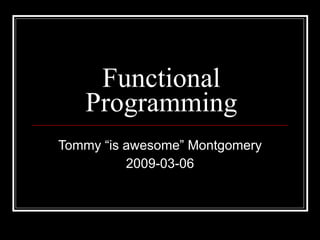
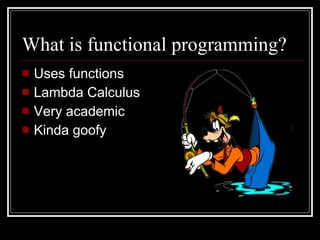



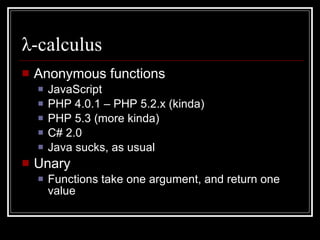
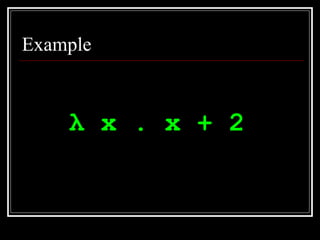
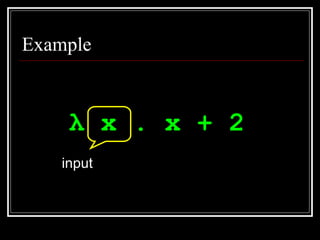
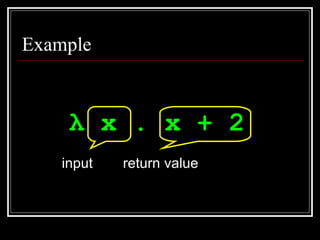



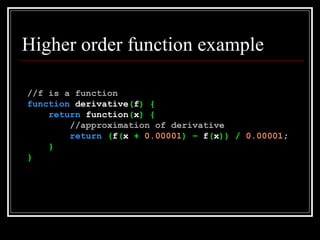
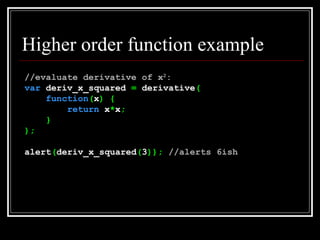


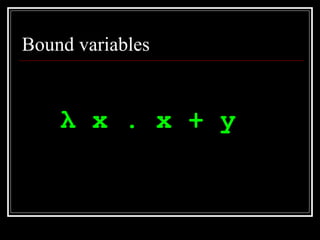
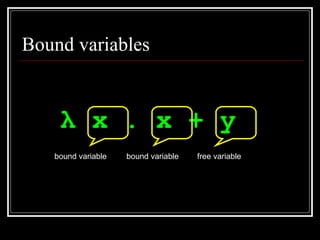



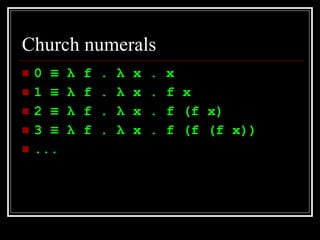
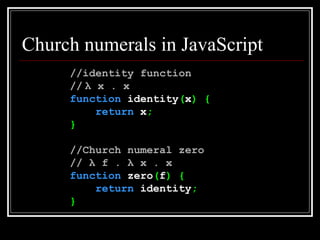
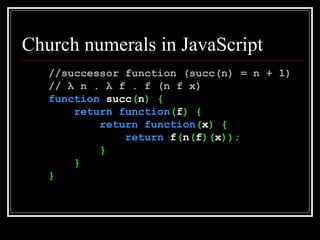

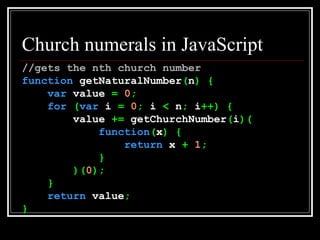


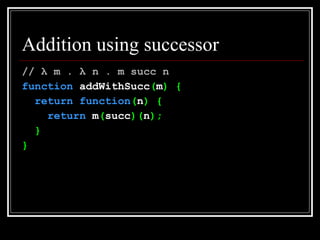


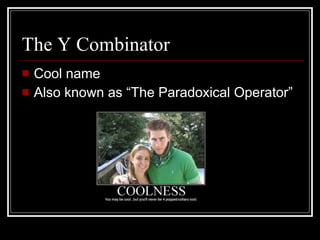









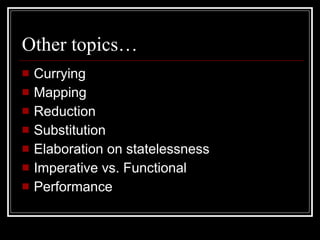


Ad
Recommended
Functional Programming in JavaScript



Functional Programming in JavaScriptWill Livengood Slides from a tech talk I gave at Fullstack Academy on functional programming concepts, as implemented in JavaScript
Javascript Exercises



Javascript ExercisesSRINIVAS KOLAPARTHI JavaScript is an object-based scripting language which is lightweight and cross-platform.
JavaScript is not a compiled language, but it is a translated language. The JavaScript Translator (embedded in the browser) is responsible for translating the JavaScript code for the web browser.
https://nextsrini.blogspot.com/
https://www.youtube.com/channel/UCqIHkbuf1uGiN8QXwWX5dkQ
C++17 Key Features Summary - Ver 2



C++17 Key Features Summary - Ver 2Chris Ohk C++은 10년 만에 C++11/14를 발표하면서 '모던 C++'이라는 이름으로 발전했습니다. 그만큼 새로운 기능들이 많이 추가되었습니다. 그리고 2017년, C++은 C++17이라는 이름으로 또 한 번의 발전을 준비하고 있습니다. 3년 주기로 빠르게 변화하는 모던 C++에 대비하기 위해, C++17에 추가될 주요 기능들을 살펴보고자 합니다.
이 발표는 이전에 발표했던 내용에서 일부 사례 추가 및 최신 내용으로 갱신한 버전입니다.
What Are Coroutines In Kotlin?



What Are Coroutines In Kotlin?Simplilearn In this tutorial on What are Coroutines in Kotlin, you will learn the basics of threads and understand how coroutines work in Kotlin. You'll look at the different features and examples of coroutines. Finally, you'll see a demo of Kotlin Coroutines.
Software Reuse and Object-Oriented Programming



Software Reuse and Object-Oriented Programmingkim.mens These slides on Software Reuse and Object-Oriented Programming are part of the course LINGI2252 “Software Maintenance and Evolution”, given by Prof. Kim Mens at UCL, Belgium
Kotlin for Android Development



Kotlin for Android DevelopmentSpeck&Tech Google is adding Kotlin as an official programming language for Android development. Kotlin is a language that runs on the JVM and has full interoperability with Java. It costs nothing to adopt! I will show some cool features of Kotlin, how it makes developing with Android easy and finally we'll see what happens under the hood when we write in Kotlin.
Final year project presentation in android application



Final year project presentation in android applicationChirag Thaker here i have prepared a pressentation for final semester project my project definition was Snaffy that is one restaurent application
Docker란 무엇인가? : Docker 기본 사용법



Docker란 무엇인가? : Docker 기본 사용법pyrasis Docker란 무엇인가? : Docker 기본 사용법
Docker Seoul Meetup #1 발표 자료입니다.
Docker 기본 개념과 사용 방법을 설명하였습니다.
Callbacks, Promises, and Coroutines (oh my!): Asynchronous Programming Patter...



Callbacks, Promises, and Coroutines (oh my!): Asynchronous Programming Patter...Domenic Denicola This talk takes a deep dive into asynchronous programming patterns and practices, with an emphasis on the promise pattern.
We go through the basics of the event loop, highlighting the drawbacks of asynchronous programming in a naive callback style. Fortunately, we can use the magic of promises to escape from callback hell with a powerful and unified interface for async APIs. Finally, we take a quick look at the possibilities for using coroutines both in current and future (ECMAScript Harmony) JavaScript.
JDBC



JDBCSunil OS The document discusses Structured Query Language (SQL) and Java Database Connectivity (JDBC). It provides examples of using SQL statements like SELECT, INSERT, UPDATE, DELETE to query and manipulate data in database tables. It also demonstrates how to connect to databases like MySQL from Java using JDBC, execute SQL queries to retrieve and manipulate data, handle transactions and exceptions. Key classes discussed are Connection, Statement, PreparedStatement, CallableStatement and their methods.
Code Refactoring



Code RefactoringHarbinger Systems - HRTech Builder of Choice This document discusses code refactoring. It begins by defining refactoring as restructuring source code to improve readability, fix bugs easily, enhance design, and introduce flexibility without changing functionality. It then provides examples of when to refactor, such as when duplicating logic exists, or to enable sharing of logic between methods. The document also discusses problems that can occur with refactoring, like interface changes breaking other applications, and signs that refactoring is needed, such as duplicate code, long methods, or large classes. It provides guidance on how to identify code that needs refactoring and techniques for refactoring different structures. In the end, it discusses the potential benefits of refactoring, such as increased
JavaScript Promises



JavaScript PromisesL&T Technology Services Limited JavaScript Promise presentation prepared for JSChannel Bengaluru Meetup on 23rd, August, 2014. It covers promise examples in jQuery, q library, AngularJS and Node.js.
Code Examples:
https://github.com/pulakb/JavaScript-Promises
Hibernate 



Hibernate Sunil OS Hibernate is an object-relational mapping tool that allows Java objects to be persisted to a relational database. It provides transparent persistence by handling all database operations like insert, update, delete, and retrieval. Hibernate sits between the Java application and database, mapping objects to database tables and allowing developers to work with objects rather than directly with SQL statements. Configuration files define the mappings between Java classes and database tables. Hibernate uses these mappings to automatically generate SQL to load and store objects.
04 Handling Exceptions



04 Handling Exceptionsrehaniltifat This document discusses handling exceptions in PL/SQL. It explains that exceptions can be raised implicitly by the Oracle server or explicitly in a program. Exceptions can be handled by trapping them with an exception handler or propagating them to the calling environment. It provides details and examples of trapping predefined Oracle exceptions, user-defined exceptions, and non-predefined Oracle exceptions. It also discusses exception handling in calling environments like procedures.
Network programming in Java



Network programming in JavaTushar B Kute The presentation given at MSBTE sponsored content updating program on 'Advanced Java Programming' for Diploma Engineering teachers of Maharashtra. Venue: Guru Gobind Singh Polytechnic, Nashik
Date: 22/12/2010
Session: Java Network Programming
JavaScript: Ajax & DOM Manipulation



JavaScript: Ajax & DOM Manipulationborkweb JavaScript workshop for PSU Information Desk employees. Discusses JavaScript, Ajax, DOM Manipulation, jQuery, etc.
Introduction to mobile application development



Introduction to mobile application developmentChandan Maurya This document discusses mobile application development. It covers the importance of mobile apps, different development choices like native, hybrid and mobile web apps, and factors to consider from the perspectives of users, developers and businesses. The key platforms are discussed along with their market shares. Native apps can access all device APIs but must be developed for each platform separately. Hybrid apps combine web technologies with native wrappers for a cross-platform experience. Mobile web apps run in browsers but have limited device access.
XML-RPC (XML Remote Procedure Call)



XML-RPC (XML Remote Procedure Call)Peter R. Egli Short overview of the XML-RPC protocol for XML-based RPC services.
XML-RPC is a remote procedure call protocol using XML as data format and HTTP as transport protocol.
It is a simple mechanism to call remote procedures on a machine with a different operating system.
XML-RPC is language and platform independent. XML-RPC libraries are available in Java and other languages.
XML-RPC is not more than its name implies and thus is very simple and lean. This means that it lacks most of the features that SOAP/WSDL web services provide.
AngularJS Directives



AngularJS DirectivesEyal Vardi This document discusses AngularJS directives and scopes. It provides examples of:
- Defining directives with isolate scopes that bind to parent scope properties using '@' for interpolation, '=' for two-way binding, and '&' for function execution.
- How child/isolate scopes inherit from parent scopes but can overwrite properties, while objects and arrays are shared by reference between parent and child.
- Using $parent to reference properties on the parent scope from within an isolate/child scope.
- The compilation process where directives are sorted and linked.
So in summary, it covers the key concepts of isolate scopes, prototypal inheritance and how directives are compiled in AngularJS.
Java Basics



Java BasicsDhanunjai Bandlamudi The document discusses basic Java concepts including identifiers, keywords, literals, primitive data types, variables, operators, control flow statements, classes, methods, inheritance, polymorphism, packages and modifiers. It provides definitions and examples of key concepts like classes, objects, methods, inheritance, polymorphism, packages, modifiers, variables and data types. It also lists Java keywords, reserved words and literals.
Structure chart



Structure chartRoy Antony Arnold G A structure chart is a top-down diagram that shows the breakdown of a system into manageable sub-modules. It represents each module as a box with lines connecting them to show relationships. Structure charts are used in software engineering to plan program structure and divide a problem into smaller tasks. They provide a hierarchical visualization of how a program or system is decomposed.
Android webservices



Android webservicesKrazy Koder The document discusses Android web services using the HttpClient API. It describes invocation styles in HttpClient as synchronous and asynchronous. It provides examples of sending HTTP requests using HttpGet and HttpPost, and receiving HTTP responses using HttpResponse and ResponseHandler interfaces. Common response formats like XML, JSON, RSS and Atom are mentioned and examples of parsing JSON responses using the JSONObject class are given.
Introduction to Android and Android Studio



Introduction to Android and Android StudioSuyash Srijan This is a presentation that I gave at Google Developer Group Oxford to introduce people to Android development and Android Studio IDE, which is used to build Android apps. This presentation gives a brief overview of the platform and fundamentals of the app and what developer tools are available.
PS: Some slides do not have any text accompanying it. That is either because it wasn't relevant or because the text would've been too long to put on the corresponding slide.
Introduction to Java Programming, Basic Structure, variables Data type, input...



Introduction to Java Programming, Basic Structure, variables Data type, input...Mr. Akaash This is First Lecture of java Programming which cover all basic points (ie. History and feature of java, Introduction to java, about variables data type and compilation....
All Your IOPS Are Belong To Us - A Pinteresting Case Study in MySQL Performan...



All Your IOPS Are Belong To Us - A Pinteresting Case Study in MySQL Performan...Ernie Souhrada Have you ever thought that your SSD storage just doesn't seem anywhere near as fast as advertised? What if I told you that a couple of small changes to your Linux servers had the potential to more than double the amount of throughput your MySQL servers could handle while simultaneously reducing query response time by around 50 percent? It's not a dream, Neo.
If you're still in a traditional data center and/or your MySQL footprint lives on spinning rust, then you might want to take the blue pill, attend a different session, and believe whatever you want to believe.
However, if your server footprint runs inside Amazon Web Services or if you use SSDs in any fashion, I invite you to take the red pill and come with me on a journey down the rabbit hole, where we'll discuss such things as the Linux block IO driver, CPU starvation, and interrupt handling, using real-world query performance data from the primary MySQL data stores at Pinterest to illustrate the effect.
Recyclerview in action 



Recyclerview in action Pratama Nur Wijaya The document provides an overview of RecyclerView in Android, including:
1. RecyclerView components like LayoutManager, Adapter, ItemDecoration, and ItemAnimator and examples of how to set them up.
2. How to create ViewHolders and Adapters to display data in RecyclerView.
3. Techniques for handling click listeners and displaying multiple view types.
4. Examples of using item decorations and animators.
5. Recommended resources for further learning about RecyclerView.
Polymorphism in C# Function overloading in C#



Polymorphism in C# Function overloading in C#Abid Kohistani In this tutorial we discuss about polymorphism and Function overloading in C# programming language
abstract class and methods will also be discussed.
From framework coupled code to #microservices through #DDD /by @codelytv



From framework coupled code to #microservices through #DDD /by @codelytvCodelyTV From framework coupled code to microservices through DDD modules. The presentation discussed the evolution from monolithic frameworks to microservices architecture through various stages:
1) Old days of framework coupled code with low autonomy, maintainability and learning curve.
2) Use of MVC frameworks improved isolation but code was still highly coupled.
3) Focus on testing drove adoption of SOLID principles at a micro scale.
4) Domain-Driven Design introduced modules per domain concept improving decoupling, semantics and testability.
5) Further decomposition into bounded contexts and microservices provided more autonomy for teams but introduced new accidental complexities around infrastructure and coordination.
Functional JavaScript Fundamentals



Functional JavaScript FundamentalsSrdjan Strbanovic This document provides an overview of functional JavaScript concepts including: type system, primitive values, objects, inheritance, functions, closures, pure functions, higher order functions, composition, currying/partial application, and functional techniques like filter, map and reduce. It recommends resources for learning more about functional programming in JavaScript like libraries, books, and workshops.
Functional Programming with JavaScript



Functional Programming with JavaScriptWebF This document discusses functional programming with JavaScript. It begins with an introduction to functions and functional programming. It then covers topics like first-class functions, higher-order functions, function composition, currying, and partial application. It also discusses common functional utilities like map, filter, and reduce. The document emphasizes writing pure and simple functions and gluing them together with other functions. It provides examples of functional programming patterns in JavaScript and recommends libraries like Ramda.js that facilitate a functional style.
More Related Content
What's hot (20)
Callbacks, Promises, and Coroutines (oh my!): Asynchronous Programming Patter...



Callbacks, Promises, and Coroutines (oh my!): Asynchronous Programming Patter...Domenic Denicola This talk takes a deep dive into asynchronous programming patterns and practices, with an emphasis on the promise pattern.
We go through the basics of the event loop, highlighting the drawbacks of asynchronous programming in a naive callback style. Fortunately, we can use the magic of promises to escape from callback hell with a powerful and unified interface for async APIs. Finally, we take a quick look at the possibilities for using coroutines both in current and future (ECMAScript Harmony) JavaScript.
JDBC



JDBCSunil OS The document discusses Structured Query Language (SQL) and Java Database Connectivity (JDBC). It provides examples of using SQL statements like SELECT, INSERT, UPDATE, DELETE to query and manipulate data in database tables. It also demonstrates how to connect to databases like MySQL from Java using JDBC, execute SQL queries to retrieve and manipulate data, handle transactions and exceptions. Key classes discussed are Connection, Statement, PreparedStatement, CallableStatement and their methods.
Code Refactoring



Code RefactoringHarbinger Systems - HRTech Builder of Choice This document discusses code refactoring. It begins by defining refactoring as restructuring source code to improve readability, fix bugs easily, enhance design, and introduce flexibility without changing functionality. It then provides examples of when to refactor, such as when duplicating logic exists, or to enable sharing of logic between methods. The document also discusses problems that can occur with refactoring, like interface changes breaking other applications, and signs that refactoring is needed, such as duplicate code, long methods, or large classes. It provides guidance on how to identify code that needs refactoring and techniques for refactoring different structures. In the end, it discusses the potential benefits of refactoring, such as increased
JavaScript Promises



JavaScript PromisesL&T Technology Services Limited JavaScript Promise presentation prepared for JSChannel Bengaluru Meetup on 23rd, August, 2014. It covers promise examples in jQuery, q library, AngularJS and Node.js.
Code Examples:
https://github.com/pulakb/JavaScript-Promises
Hibernate 



Hibernate Sunil OS Hibernate is an object-relational mapping tool that allows Java objects to be persisted to a relational database. It provides transparent persistence by handling all database operations like insert, update, delete, and retrieval. Hibernate sits between the Java application and database, mapping objects to database tables and allowing developers to work with objects rather than directly with SQL statements. Configuration files define the mappings between Java classes and database tables. Hibernate uses these mappings to automatically generate SQL to load and store objects.
04 Handling Exceptions



04 Handling Exceptionsrehaniltifat This document discusses handling exceptions in PL/SQL. It explains that exceptions can be raised implicitly by the Oracle server or explicitly in a program. Exceptions can be handled by trapping them with an exception handler or propagating them to the calling environment. It provides details and examples of trapping predefined Oracle exceptions, user-defined exceptions, and non-predefined Oracle exceptions. It also discusses exception handling in calling environments like procedures.
Network programming in Java



Network programming in JavaTushar B Kute The presentation given at MSBTE sponsored content updating program on 'Advanced Java Programming' for Diploma Engineering teachers of Maharashtra. Venue: Guru Gobind Singh Polytechnic, Nashik
Date: 22/12/2010
Session: Java Network Programming
JavaScript: Ajax & DOM Manipulation



JavaScript: Ajax & DOM Manipulationborkweb JavaScript workshop for PSU Information Desk employees. Discusses JavaScript, Ajax, DOM Manipulation, jQuery, etc.
Introduction to mobile application development



Introduction to mobile application developmentChandan Maurya This document discusses mobile application development. It covers the importance of mobile apps, different development choices like native, hybrid and mobile web apps, and factors to consider from the perspectives of users, developers and businesses. The key platforms are discussed along with their market shares. Native apps can access all device APIs but must be developed for each platform separately. Hybrid apps combine web technologies with native wrappers for a cross-platform experience. Mobile web apps run in browsers but have limited device access.
XML-RPC (XML Remote Procedure Call)



XML-RPC (XML Remote Procedure Call)Peter R. Egli Short overview of the XML-RPC protocol for XML-based RPC services.
XML-RPC is a remote procedure call protocol using XML as data format and HTTP as transport protocol.
It is a simple mechanism to call remote procedures on a machine with a different operating system.
XML-RPC is language and platform independent. XML-RPC libraries are available in Java and other languages.
XML-RPC is not more than its name implies and thus is very simple and lean. This means that it lacks most of the features that SOAP/WSDL web services provide.
AngularJS Directives



AngularJS DirectivesEyal Vardi This document discusses AngularJS directives and scopes. It provides examples of:
- Defining directives with isolate scopes that bind to parent scope properties using '@' for interpolation, '=' for two-way binding, and '&' for function execution.
- How child/isolate scopes inherit from parent scopes but can overwrite properties, while objects and arrays are shared by reference between parent and child.
- Using $parent to reference properties on the parent scope from within an isolate/child scope.
- The compilation process where directives are sorted and linked.
So in summary, it covers the key concepts of isolate scopes, prototypal inheritance and how directives are compiled in AngularJS.
Java Basics



Java BasicsDhanunjai Bandlamudi The document discusses basic Java concepts including identifiers, keywords, literals, primitive data types, variables, operators, control flow statements, classes, methods, inheritance, polymorphism, packages and modifiers. It provides definitions and examples of key concepts like classes, objects, methods, inheritance, polymorphism, packages, modifiers, variables and data types. It also lists Java keywords, reserved words and literals.
Structure chart



Structure chartRoy Antony Arnold G A structure chart is a top-down diagram that shows the breakdown of a system into manageable sub-modules. It represents each module as a box with lines connecting them to show relationships. Structure charts are used in software engineering to plan program structure and divide a problem into smaller tasks. They provide a hierarchical visualization of how a program or system is decomposed.
Android webservices



Android webservicesKrazy Koder The document discusses Android web services using the HttpClient API. It describes invocation styles in HttpClient as synchronous and asynchronous. It provides examples of sending HTTP requests using HttpGet and HttpPost, and receiving HTTP responses using HttpResponse and ResponseHandler interfaces. Common response formats like XML, JSON, RSS and Atom are mentioned and examples of parsing JSON responses using the JSONObject class are given.
Introduction to Android and Android Studio



Introduction to Android and Android StudioSuyash Srijan This is a presentation that I gave at Google Developer Group Oxford to introduce people to Android development and Android Studio IDE, which is used to build Android apps. This presentation gives a brief overview of the platform and fundamentals of the app and what developer tools are available.
PS: Some slides do not have any text accompanying it. That is either because it wasn't relevant or because the text would've been too long to put on the corresponding slide.
Introduction to Java Programming, Basic Structure, variables Data type, input...



Introduction to Java Programming, Basic Structure, variables Data type, input...Mr. Akaash This is First Lecture of java Programming which cover all basic points (ie. History and feature of java, Introduction to java, about variables data type and compilation....
All Your IOPS Are Belong To Us - A Pinteresting Case Study in MySQL Performan...



All Your IOPS Are Belong To Us - A Pinteresting Case Study in MySQL Performan...Ernie Souhrada Have you ever thought that your SSD storage just doesn't seem anywhere near as fast as advertised? What if I told you that a couple of small changes to your Linux servers had the potential to more than double the amount of throughput your MySQL servers could handle while simultaneously reducing query response time by around 50 percent? It's not a dream, Neo.
If you're still in a traditional data center and/or your MySQL footprint lives on spinning rust, then you might want to take the blue pill, attend a different session, and believe whatever you want to believe.
However, if your server footprint runs inside Amazon Web Services or if you use SSDs in any fashion, I invite you to take the red pill and come with me on a journey down the rabbit hole, where we'll discuss such things as the Linux block IO driver, CPU starvation, and interrupt handling, using real-world query performance data from the primary MySQL data stores at Pinterest to illustrate the effect.
Recyclerview in action 



Recyclerview in action Pratama Nur Wijaya The document provides an overview of RecyclerView in Android, including:
1. RecyclerView components like LayoutManager, Adapter, ItemDecoration, and ItemAnimator and examples of how to set them up.
2. How to create ViewHolders and Adapters to display data in RecyclerView.
3. Techniques for handling click listeners and displaying multiple view types.
4. Examples of using item decorations and animators.
5. Recommended resources for further learning about RecyclerView.
Polymorphism in C# Function overloading in C#



Polymorphism in C# Function overloading in C#Abid Kohistani In this tutorial we discuss about polymorphism and Function overloading in C# programming language
abstract class and methods will also be discussed.
From framework coupled code to #microservices through #DDD /by @codelytv



From framework coupled code to #microservices through #DDD /by @codelytvCodelyTV From framework coupled code to microservices through DDD modules. The presentation discussed the evolution from monolithic frameworks to microservices architecture through various stages:
1) Old days of framework coupled code with low autonomy, maintainability and learning curve.
2) Use of MVC frameworks improved isolation but code was still highly coupled.
3) Focus on testing drove adoption of SOLID principles at a micro scale.
4) Domain-Driven Design introduced modules per domain concept improving decoupling, semantics and testability.
5) Further decomposition into bounded contexts and microservices provided more autonomy for teams but introduced new accidental complexities around infrastructure and coordination.
Viewers also liked (14)
Functional JavaScript Fundamentals



Functional JavaScript FundamentalsSrdjan Strbanovic This document provides an overview of functional JavaScript concepts including: type system, primitive values, objects, inheritance, functions, closures, pure functions, higher order functions, composition, currying/partial application, and functional techniques like filter, map and reduce. It recommends resources for learning more about functional programming in JavaScript like libraries, books, and workshops.
Functional Programming with JavaScript



Functional Programming with JavaScriptWebF This document discusses functional programming with JavaScript. It begins with an introduction to functions and functional programming. It then covers topics like first-class functions, higher-order functions, function composition, currying, and partial application. It also discusses common functional utilities like map, filter, and reduce. The document emphasizes writing pure and simple functions and gluing them together with other functions. It provides examples of functional programming patterns in JavaScript and recommends libraries like Ramda.js that facilitate a functional style.
Functional Programming with JavaScript



Functional Programming with JavaScriptAung Baw Functional programming is a programming paradigm that treats computation as the evaluation of mathematical functions and avoids changing-state and mutable data. Some key aspects of functional programming include: breaking problems down into smaller pure functions, using functions as first-class citizens that can be passed in and returned from other functions, avoiding side effects from functions, and embracing concepts like referential transparency. JavaScript supports functional programming with features like first-class functions, higher-order functions, immutability, and functional utilities like map and reduce. Functional programming can make code more readable, reusable, and easier to understand when working with larger teams or on larger applications.
Interactive Scientific Image Analysis using Spark



Interactive Scientific Image Analysis using SparkKevin Mader Many important scientific questions ranging from the micro-scale mechanical behavior of foam structures to the process of viral infection in cells demand not only high spatial, but also temporal resolution. Detector improvements have made realizing many of these experiments possible, and have consequently produced a flood of rich image data. At the TOMCAT beamline of the Swiss Light Source peak acquisition rates reach 8GB/s [1] and frequently cumulate to 10s or 100s of terabytes per day. While visual inspection is invaluable, detailed quantitative analysis is essential for summarizing and comparing samples and performing hypothesis tests. Even more important is the ability to detect outlier events and unexpected structures buried deep inside the voluminous data. Existing tools scale poorly beyond single computers and make this type of interactive exploration very difficult and time consuming. We have developed a scalable framework based on Apache Spark and the Resilient Distributed Datasets proposed in [2] for parallel, distributed, real-time image processing and quantitative analysis [3]. The distributed evaluation tool performs filtering, segmentation and shape analysis enabling data exploration and hypothesis testing over millions of structures with the time frame of an experiment. The tools have been tested with clusters containing thousands of machines and images containing more than 100 billion voxels. Furthermore we have expanded this tool using technologies like OpenLayers [4] and D3.js [5] to make the analysis reachable to even non-technical users. We show how these tools can be used to answer long-standing questions and see small genetically driven structural changes in bone, topology rearrangements in liquid foam, and track the course of infection in living cells. We finally demonstrate our future road map including real-time image processing using Spark Streaming and approximate analysis using BlinkDB.
Functional programming



Functional programmingedusmildo 1. Functional programming uses functions and avoids variables and assignments.
2. In functional programming, programs are represented as mathematical functions where inputs map to outputs without side effects.
3. Key aspects of functional programming include recursion instead of loops, higher-order functions, and referential transparency where functions always produce the same output for the same inputs.
Functional Programming Fundamentals



Functional Programming FundamentalsShahriar Hyder The objectives of the seminar are to shed a light on the premises of FP and give you a basic understanding of the pillars of FP so that you would feel enlightened at the end of the session. When you walk away from the seminar you should feel an inner light about the new way of programming and an urge & motivation to code like you never before did!
Functional programming should not be confused with imperative (or procedural) programming. Neither it is like object oriented programming. It is something different. Not radically so, since the concepts that we will be exploring are familiar programming concepts, just expressed in a different way. The philosophy behind how these concepts are applied to solving problems are also a little different. We shall learn and talk about essentially the fundamental elements of Functional Programming.
Lambda Calculus by Dustin Mulcahey 



Lambda Calculus by Dustin Mulcahey Hakka Labs This is a friendly Lambda Calculus Introduction by Dustin Mulcahey. LISP has its syntactic roots in a formal system called the lambda calculus. After a brief discussion of formal systems and logic in general, Dustin will dive in to the lambda calculus and make enough constructions to convince you that it really is capable of expressing anything that is "computable". Dustin then talks about the simply typed lambda calculus and the Curry-Howard-Lambek correspondence, which asserts that programs and mathematical proofs are "the same thing".
Machine Learning with Apache Mahout



Machine Learning with Apache MahoutDaniel Glauser This document provides an introduction to machine learning with Apache Mahout. It defines machine learning as a branch of artificial intelligence that uses statistics and large datasets to make smart decisions. Common applications include spam filtering, credit card fraud detection, medical diagnostics, and search engines. Apache Mahout is a platform for machine learning algorithms that allows users to build their own algorithms or use existing functionality like recommender engines, classification, and clustering.
Functional programming



Functional programmingPrateek Jain This document discusses functional programming (FP) as an alternative to object-oriented programming (OOP). It notes issues with OOP like null pointer problems and inheritance issues. It then gives reasons for using FP like the need to write concurrent programs and handle data management problems. FP is described as using recursion instead of loops, higher-order functions, and treating programs as mathematical functions. FP avoids variables and assignments and favors immutability. Examples of FP languages provided are Erlang, Haskell and Clojure. Caution is given around maintainability, advocating for readability over one-liners. Real-world adoptions of FP at companies like Facebook and LinkedIn are also mentioned.
The Lambda Calculus and The JavaScript



The Lambda Calculus and The JavaScriptNorman Richards The document discusses the lambda calculus and its relationship to functional programming and JavaScript. It introduces Alonzo Church as the creator of lambda calculus and its use as the basis for functional programming. It then provides examples of lambda expressions, applications, and combinators to illustrate core concepts in lambda calculus and how it enables Turing completeness.
Functional Programming in JavaScript by Luis Atencio



Functional Programming in JavaScript by Luis AtencioLuis Atencio This document provides an overview of functional programming concepts using JavaScript. It discusses thinking functionally by avoiding side effects, writing declaratively, and ensuring functions always return values. Functional techniques like currying, composition, and memoization are explained. It also covers paradigms like referential transparency and the Liskov substitution principle. The document discusses how JavaScript supports functional programming with features like closures and higher-order functions. Common libraries for functional programming in JavaScript are listed. Finally, the document covers advanced topics like functors, monads, and how they can be used for error handling.
Modeling with Hadoop kdd2011



Modeling with Hadoop kdd2011Milind Bhandarkar This document discusses modeling algorithms using the MapReduce framework. It outlines types of learning that can be done in MapReduce, including parallel training of models, ensemble methods, and distributed algorithms that fit the statistical query model (SQM). Specific algorithms that can be implemented in MapReduce are discussed, such as linear regression, naive Bayes, logistic regression, and decision trees. The document provides examples of how these algorithms can be formulated and computed in a MapReduce paradigm by distributing computations across mappers and reducers.
Functional programming ii



Functional programming iiPrashant Kalkar The document discusses functional programming and pattern matching. It provides examples of using pattern matching in functional programming to:
1. Match on algebraic data types like lists to traverse and operate on data in a recursive manner. Pattern matching allows adding new operations easily by adding new patterns.
2. Use pattern matching in variable declarations to destructure data like tuples and case class objects.
3. Perform pattern matching on function parameters to selectively apply different logic based on the patterns, like filtering even numbers from a list. Everything can be treated as values and expressions in functional programming.
Predictive Analytics Project in Automotive Industry



Predictive Analytics Project in Automotive IndustryMatouš Havlena Original article: http://www.havlena.net/en/business-analytics-intelligence/predictive-analytics-project-in-automotive-industry/
I had a chance to work on a predictive analytics project for a US car manufacturer. The goal of the project was to evaluate the feasibility to use Big Data analysis solutions for manufacturing to solve different operational needs. The objective was to determine a business case and identify a technical solution (vendor). Our task was to analyze production history data and predict car inspection failures from the production line. We obtained historical data on defects on the car, how the car moved along the assembly line and car specific information like engine type, model, color, transmission type, and so on. The data covered the whole manufacturing history for one year. We used IBM BigInsights and SPSS Modeler to make the predictions.
Ad
Similar to Introduction to Functional Programming in JavaScript (20)
TI1220 Lecture 6: First-class Functions



TI1220 Lecture 6: First-class FunctionsEelco Visser This document discusses first-class functions and lambda calculus. It begins with an overview of Alonzo Church and the origins of lambda calculus. It then covers first-class functions in JavaScript, functions as objects in Java, and first-class functions in Scala. The document also discusses generic higher-order functions and control abstraction.
Composition birds-and-recursion



Composition birds-and-recursionDavid Atchley The document discusses function composition and recursion in JavaScript. It introduces basic functions like double, square, and inc. It then shows how to work with these functions in an imperative style using a for loop, and in a declarative style using map. It discusses how composition allows building complexity by combining functions. The document also discusses combinators, introducing birds that represent functions like identity, mockingbird, bluebird (compose), lark, and meadowlark. It concludes by explaining the Y-combinator and how it allows recursion using fixed points.
Functional Programming Concepts for Imperative Programmers



Functional Programming Concepts for Imperative ProgrammersChris The document discusses functional programming concepts including the origins of the λ-calculus and Lisp. It covers functions as data, lambda expressions, closures, function composition, and higher-order functions. Examples are provided in JavaScript and Scala of implementing functions like fold to operate on lists. While many functional concepts are covered, topics like currying, monads, and lazy evaluation are noted but not discussed in detail.
User defined functions



User defined functionsshubham_jangid The document discusses functions in C++. It defines functions as modules that can be called to break programs into smaller pieces, making code easier to design, build, debug and maintain. It provides examples of function definitions and calls. Functions take arguments, make copies of them, perform tasks, and return results. Function prototypes specify argument and return types. Well-designed programs use preexisting and new functions to organize and reuse code.
Functors, applicatives, monads



Functors, applicatives, monadsrkaippully The document discusses functors, applicatives, and monads in Haskell. It provides examples of how functors allow lifting functions to work on container types like Maybe and Logger using fmap. Applicatives allow applying functions to multiple arguments within a container using <*>. Monads generalize applicatives by allowing chained computations through >>= and return, handling context and effects like logging.
Functional programming java



Functional programming javaManeesh Chaturvedi Here is how to convert the method into a curried function:
Function<A, Function<B, Function<C, Function<D, String>>>> func =
a -> b -> c -> d -> String.format("%s, %s, %s, %s", a, b, c, d);
This defines func as a function that takes an argument of type A and returns a function that takes B and returns a function that takes C and returns a function that takes D and returns a String.
Functions123 



Functions123 sandhubuta The document discusses user-defined functions in C++. It explains that functions help divide programs into smaller, more manageable pieces. Functions are defined with a return type, parameter list, and function body. Functions are called by name with arguments in parentheses. Parameters allow functions to access external information. Function prototypes specify the signature of the function. Functions can return values or be defined as void if they do not return anything.
Functions12



Functions12sandhubuta The document discusses user-defined functions in C++. It explains that functions help divide programs into smaller, more manageable pieces. Functions are defined with a return type, parameter list, and function body. Functions can take arguments and return values. Function prototypes specify the function signature. Functions can be called by name and passed arguments. Global variables are accessible everywhere while local variables are only accessible within their function.
Deriving the Y Combinator



Deriving the Y CombinatorYuta Okazaki (日本語説明下記)Here I try to derive the Y Combinator as simple as possible.
Yコンビネータは、変数を使わずに再帰関数をつくるための便利な考え方です。 Y Combinatorという名前は、同名のシリコンバレーの起業家支援プログラムが登場したため、一躍有名になりました(Google検索が難しくなりました)。
こっちの Y Combinatorを検索したいときは、
「Y Combinator 再帰」「Y Combinator ラムダ」などで検索してみてください。
Functional object



Functional objectruchijindal87 Functional objects are immutable objects that do not have mutable state. They allow functions to be passed as arguments and returned from other functions. The document introduces functional objects using the example of a Rational number class in Scala. It demonstrates how to define a Rational class with immutable fields and methods like addition, constructors, and equality checks.
Let Us Learn Lambda Using C# 3.0



Let Us Learn Lambda Using C# 3.0Sheik Uduman Ali First part of this presentation explains basics and advantages of using functional programming approaches with lambda calculus.
Second part of this presentation explains how can we use lambda calculus in C# 3.0
functions



functionsMakwana Bhavesh The document is a report on the topic of computer programming and utilization prepared by group C. It discusses functions, including the definition of a function, function examples, benefits of functions, function prototypes, function arguments, and recursion. It provides examples of math library functions, global and local variables, and external variables. It also includes examples of recursive functions to calculate factorials and the Fibonacci series recursively.
Столпы функционального программирования для адептов ООП, Николай Мозговой



Столпы функционального программирования для адептов ООП, Николай МозговойSigma Software This document provides an overview of functional programming concepts for object-oriented programmers. It discusses the fundamentals of FP including immutability, purity, first-class and higher-order functions, closures, and recursion. It provides examples of these concepts in languages like Lisp, F#, C#, and JavaScript. The document also compares OO and FP concepts and discusses derived FP concepts like partial application, lazy evaluation, and pattern matching.
Module 2 topic 2 notes



Module 2 topic 2 noteschrystal_brinson This document discusses function operations such as addition, subtraction, multiplication, and division. It provides examples of writing expressions for the sum, difference, product, and quotient of two functions. It also addresses the domain and range of combined functions. Specifically, it gives an example of writing functions to model the distance traveled and effect of wind for an airplane traveling at a constant speed.
Advanced JavaScript 



Advanced JavaScript Zsolt Mészárovics This document summarizes advanced JavaScript concepts including:
- Object-oriented inheritance patterns in JavaScript and trends toward avoiding new and emulating private members. Pseudo-classical inheritance is recommended for better performance.
- Exploiting JavaScript's support for functional programming with higher-order functions to allow functions as arguments and return values for more flexible programming.
- Common issues with asynchronous code in JavaScript and how promises can help address callbacks and synchronization.
- Common pitfalls to avoid with arrays, numbers, and typeof in JavaScript.
List-based Monadic Computations for Dynamic Languages



List-based Monadic Computations for Dynamic LanguagesWim Vanderbauwhede These are the slides of the talk I gave at the Dyla'14 workshop (http://conferences.inf.ed.ac.uk/pldi2014/). It's about monads for languages like Perl, Ruby and LiveScript.
The source code is available at
https://github.com/wimvanderbauwhede/Perl-Parser-Combinators
https://github.com/wimvanderbauwhede/parser-combinators-ls
Don't be put off by the word monad or the maths. This is basically a very practical way for doing tasks such as parsing.
Part 3-functions



Part 3-functionsankita44 The document discusses user-defined functions in C++. It defines functions as modules that help develop and maintain large programs by breaking them into smaller pieces. Functions allow code reusability by defining blocks of code that can be invoked multiple times from different parts of a program. The document provides examples of function definitions, prototypes, calling functions by passing arguments, and defining functions that return values. It also discusses local variables, parameters, and built-in math library functions.
Programming in Scala - Lecture Two



Programming in Scala - Lecture TwoAngelo Corsaro This document provides an overview of a lecture on functional programming in Scala. It covers the following topics:
1. A recap of functional programming principles like functions as first-class values and no side effects.
2. An introduction to the Haskell programming language including its syntax for defining functions.
3. How functions are defined in Scala and how they are objects at runtime.
4. Examples of defining the factorial function recursively in Haskell and Scala, and making it tail recursive.
5. Concepts of first-class functions, currying, partial application, and an example of implementing looping in Scala using these techniques.
TypeScript Introduction



TypeScript IntroductionDmitry Sheiko Not so long ago Microsoft announced a new language trageting on front-end developers. Everybody's reaction was like: Why?!! Is it just Microsoft darting back to Google?!
So, why a new language? JavaScript has its bad parts. Mostly you can avoid them or workaraund. You can emulate class-based OOP style, modules, scoping and even run-time typing. But that is doomed to be clumsy. That's not in the language design. Google has pointed out these flaws, provided a new language and failed. Will the story of TypeScript be any different?
Ad
Recently uploaded (20)
Scaling GenAI Inference From Prototype to Production: Real-World Lessons in S...



Scaling GenAI Inference From Prototype to Production: Real-World Lessons in S...Anish Kumar Presented by: Anish Kumar
LinkedIn: https://www.linkedin.com/in/anishkumar/
This lightning talk dives into real-world GenAI projects that scaled from prototype to production using Databricks’ fully managed tools. Facing cost and time constraints, we leveraged four key Databricks features—Workflows, Model Serving, Serverless Compute, and Notebooks—to build an AI inference pipeline processing millions of documents (text and audiobooks).
This approach enables rapid experimentation, easy tuning of GenAI prompts and compute settings, seamless data iteration and efficient quality testing—allowing Data Scientists and Engineers to collaborate effectively. Learn how to design modular, parameterized notebooks that run concurrently, manage dependencies and accelerate AI-driven insights.
Whether you're optimizing AI inference, automating complex data workflows or architecting next-gen serverless AI systems, this session delivers actionable strategies to maximize performance while keeping costs low.
Your startup on AWS - How to architect and maintain a Lean and Mean account



Your startup on AWS - How to architect and maintain a Lean and Mean accountangelo60207 Prevent infrastructure costs from becoming a significant line item on your startup’s budget! Serial entrepreneur and software architect Angelo Mandato will share his experience with AWS Activate (startup credits from AWS) and knowledge on how to architect a lean and mean AWS account ideal for budget minded and bootstrapped startups. In this session you will learn how to manage a production ready AWS account capable of scaling as your startup grows for less than $100/month before credits. We will discuss AWS Budgets, Cost Explorer, architect priorities, and the importance of having flexible, optimized Infrastructure as Code. We will wrap everything up discussing opportunities where to save with AWS services such as S3, EC2, Load Balancers, Lambda Functions, RDS, and many others.
Data Virtualization: Bringing the Power of FME to Any Application



Data Virtualization: Bringing the Power of FME to Any ApplicationSafe Software Imagine building web applications or dashboards on top of all your systems. With FME’s new Data Virtualization feature, you can deliver the full CRUD (create, read, update, and delete) capabilities on top of all your data that exploit the full power of FME’s all data, any AI capabilities. Data Virtualization enables you to build OpenAPI compliant API endpoints using FME Form’s no-code development platform.
In this webinar, you’ll see how easy it is to turn complex data into real-time, usable REST API based services. We’ll walk through a real example of building a map-based app using FME’s Data Virtualization, and show you how to get started in your own environment – no dev team required.
What you’ll take away:
-How to build live applications and dashboards with federated data
-Ways to control what’s exposed: filter, transform, and secure responses
-How to scale access with caching, asynchronous web call support, with API endpoint level security.
-Where this fits in your stack: from web apps, to AI, to automation
Whether you’re building internal tools, public portals, or powering automation – this webinar is your starting point to real-time data delivery.
Create Your First AI Agent with UiPath Agent Builder



Create Your First AI Agent with UiPath Agent BuilderDianaGray10 Join us for an exciting virtual event where you'll learn how to create your first AI Agent using UiPath Agent Builder. This session will cover everything you need to know about what an agent is and how easy it is to create one using the powerful AI-driven UiPath platform. You'll also discover the steps to successfully publish your AI agent. This is a wonderful opportunity for beginners and enthusiasts to gain hands-on insights and kickstart their journey in AI-powered automation.
Developing Schemas with FME and Excel - Peak of Data & AI 2025



Developing Schemas with FME and Excel - Peak of Data & AI 2025Safe Software When working with other team members who may not know the Esri GIS platform or may not be database professionals; discussing schema development or changes can be difficult. I have been using Excel to help illustrate and discuss schema design/changes during meetings and it has proven a useful tool to help illustrate how a schema will be built. With just a few extra columns, that Excel file can be sent to FME to create new feature classes/tables. This presentation will go thru the steps needed to accomplish this task and provide some lessons learned and tips/tricks that I use to speed the process.
DevOps in the Modern Era - Thoughtfully Critical Podcast



DevOps in the Modern Era - Thoughtfully Critical PodcastChris Wahl https://youtu.be/735hP_01WV0
My journey through the world of DevOps! From the early days of breaking down silos between developers and operations to the current complexities of cloud-native environments. I'll talk about my personal experiences, the challenges we faced, and how the role of a DevOps engineer has evolved.
soulmaite review - Find Real AI soulmate review



soulmaite review - Find Real AI soulmate reviewSoulmaite Looking for an honest take on Soulmaite? This Soulmaite review covers everything you need to know—from features and pricing to how well it performs as a real AI soulmate. We share how users interact with adult chat features, AI girlfriend 18+ options, and nude AI chat experiences. Whether you're curious about AI roleplay porn or free AI NSFW chat with no sign-up, this review breaks it down clearly and informatively.
Jeremy Millul - A Talented Software Developer



Jeremy Millul - A Talented Software DeveloperJeremy Millul Jeremy Millul is a talented software developer based in NYC, known for leading impactful projects such as a Community Engagement Platform and a Hiking Trail Finder. Using React, MongoDB, and geolocation tools, Jeremy delivers intuitive applications that foster engagement and usability. A graduate of NYU’s Computer Science program, he brings creativity and technical expertise to every project, ensuring seamless user experiences and meaningful results in software development.
Compliance-as-a-Service document pdf text



Compliance-as-a-Service document pdf textEarthling security Earthling Security’s Compliance as a Service (CaaS) delivers ongoing, end-to-end support to help organizations meet and maintain complex cybersecurity and regulatory standards like FedRAMP, FISMA, NIST 800-53, and more. We combine expert advisory, automated tools, and continuous monitoring to reduce your compliance burden, lower risk, and ensure you stay audit-ready — all through a scalable, subscription-based model.
TimeSeries Machine Learning - PyData London 2025



TimeSeries Machine Learning - PyData London 2025Suyash Joshi Timeseries Machine Learning - forecasting and anomaly detection with InfluxDB
IntroSlides-May-BuildWithAi-EarthEngine.pdf



IntroSlides-May-BuildWithAi-EarthEngine.pdfLuiz Carneiro Introduction slides for the #BuildWithAi workshop on the 27th of May 2025 at the Google Office in Munich.
Establish Visibility and Manage Risk in the Supply Chain with Anchore SBOM



Establish Visibility and Manage Risk in the Supply Chain with Anchore SBOMAnchore Over 70% of any given software application consumes open source software (most likely not even from the original source) and only 15% of organizations feel confident in their risk management practices.
With the newly announced Anchore SBOM feature, teams can start safely consuming OSS while mitigating security and compliance risks. Learn how to import SBOMs in industry-standard formats (SPDX, CycloneDX, Syft), validate their integrity, and proactively address vulnerabilities within your software ecosystem.
Mark Zuckerberg teams up with frenemy Palmer Luckey to shape the future of XR...



Mark Zuckerberg teams up with frenemy Palmer Luckey to shape the future of XR...Scott M. Graffius Mark Zuckerberg teams up with frenemy Palmer Luckey to shape the future of XR/VR/AR wearables 🥽
Drawing on his background in AI, Agile, hardware, software, gaming, and defense, Scott M. Graffius explores the collaboration in “Meta and Anduril’s EagleEye and the Future of XR: How Gaming, AI, and Agile are Transforming Defense.” It’s a powerful case of cross-industry innovation—where gaming meets battlefield tech.
📖 Read the article: https://www.scottgraffius.com/blog/files/meta-and-anduril-eagleeye-and-the-future-of-xr-how-gaming-ai-and-agile-are-transforming-defense.html
#Agile #AI #AR #ArtificialIntelligence #AugmentedReality #Defense #DefenseTech #EagleEye #EmergingTech #ExtendedReality #ExtremeReality #FutureOfTech #GameDev #GameTech #Gaming #GovTech #Hardware #Innovation #Meta #MilitaryInnovation #MixedReality #NationalSecurity #TacticalTech #Tech #TechConvergence #TechInnovation #VirtualReality #XR
6th Power Grid Model Meetup - 21 May 2025



6th Power Grid Model Meetup - 21 May 2025DanBrown980551 6th Power Grid Model Meetup
Join the Power Grid Model community for an exciting day of sharing experiences, learning from each other, planning, and collaborating.
This hybrid in-person/online event will include a full day agenda, with the opportunity to socialize afterwards for in-person attendees.
If you have a hackathon proposal, tell us when you register!
About Power Grid Model
The global energy transition is placing new and unprecedented demands on Distribution System Operators (DSOs). Alongside upgrades to grid capacity, processes such as digitization, capacity optimization, and congestion management are becoming vital for delivering reliable services.
Power Grid Model is an open source project from Linux Foundation Energy and provides a calculation engine that is increasingly essential for DSOs. It offers a standards-based foundation enabling real-time power systems analysis, simulations of electrical power grids, and sophisticated what-if analysis. In addition, it enables in-depth studies and analysis of the electrical power grid’s behavior and performance. This comprehensive model incorporates essential factors such as power generation capacity, electrical losses, voltage levels, power flows, and system stability.
Power Grid Model is currently being applied in a wide variety of use cases, including grid planning, expansion, reliability, and congestion studies. It can also help in analyzing the impact of renewable energy integration, assessing the effects of disturbances or faults, and developing strategies for grid control and optimization.
Introduction to Typescript - GDG On Campus EUE



Introduction to Typescript - GDG On Campus EUEGoogle Developer Group On Campus European Universities in Egypt Interested in leveling up your JavaScript skills? Join us for our Introduction to TypeScript workshop.
Learn how TypeScript can improve your code with dynamic typing, better tooling, and cleaner architecture. Whether you're a beginner or have some experience with JavaScript, this session will give you a solid foundation in TypeScript and how to integrate it into your projects.
Workshop content:
- What is TypeScript?
- What is the problem with JavaScript?
- Why TypeScript is the solution
- Coding demo
Boosting MySQL with Vector Search -THE VECTOR SEARCH CONFERENCE 2025 .pdf



Boosting MySQL with Vector Search -THE VECTOR SEARCH CONFERENCE 2025 .pdfAlkin Tezuysal As the demand for vector databases and Generative AI continues to rise, integrating vector storage and search capabilities into traditional databases has become increasingly important. This session introduces the *MyVector Plugin*, a project that brings native vector storage and similarity search to MySQL. Unlike PostgreSQL, which offers interfaces for adding new data types and index methods, MySQL lacks such extensibility. However, by utilizing MySQL's server component plugin and UDF, the *MyVector Plugin* successfully adds a fully functional vector search feature within the existing MySQL + InnoDB infrastructure, eliminating the need for a separate vector database. The session explains the technical aspects of integrating vector support into MySQL, the challenges posed by its architecture, and real-world use cases that showcase the advantages of combining vector search with MySQL's robust features. Attendees will leave with practical insights on how to add vector search capabilities to their MySQL systems.
Domino IQ – What to Expect, First Steps and Use Cases



Domino IQ – What to Expect, First Steps and Use Casespanagenda Webinar Recording: https://www.panagenda.com/webinars/domino-iq-what-to-expect-first-steps-and-use-cases/
HCL Domino iQ Server – From Ideas Portal to implemented Feature. Discover what it is, what it isn’t, and explore the opportunities and challenges it presents.
Key Takeaways
- What are Large Language Models (LLMs) and how do they relate to Domino iQ
- Essential prerequisites for deploying Domino iQ Server
- Step-by-step instructions on setting up your Domino iQ Server
- Share and discuss thoughts and ideas to maximize the potential of Domino iQ
Introduction to Typescript - GDG On Campus EUE



Introduction to Typescript - GDG On Campus EUEGoogle Developer Group On Campus European Universities in Egypt
Introduction to Functional Programming in JavaScript
- 1. Functional Programming Tommy “is awesome” Montgomery 2009-03-06
- 2. What is functional programming? Uses functions Lambda Calculus Very academic Kinda goofy
- 3. Elements of functional languages Recursion Functions (der) No state
- 4. Functional Languages Haskell Erlang F# OCaml Scheme Smalltalk J K Mathematica XSLT LISP (kinda)
- 5. Fun Fact #1 Tommy was once a professional musician
- 6. λ -c alculus Anonymous functions JavaScript PHP 4.0.1 – PHP 5.2.x (kinda) PHP 5.3 (more kinda) C# 2.0 Java sucks, as usual Unary Functions take one argument, and return one value
- 7. Example λ x . x + 2
- 8. Example λ x . x + 2 input
- 9. Example λ x . x + 2 input return value
- 10. Example λ x . x + 2 input return value f(x) = x + 2
- 11. Higher order functions Functions that take functions as arguments and return functions Where the real power of functional programming lies
- 12. Higher order function example Mathematical derivative
- 13. Higher order function example //f is a function function derivative ( f ) { return function ( x ) { //approximation of derivative return ( f ( x + 0.00001 ) – f ( x )) / 0.00001 ; } }
- 14. Higher order function example //evaluate derivative of x 2 : var deriv_x_squared = derivative ( function ( x ) { return x * x ; } ); alert ( deriv_x_squared ( 3 )); //alerts 6ish
- 15. Fun Fact #2 Tommy used to be a gangsta
- 16. Bound variables The λ operator binds its variables to its scope All other variables are “free” Freedom
- 17. Bound variables λ x . x + y
- 18. Bound variables λ x . x + y bound variable bound variable free variable
- 19. Bound variables λ x . x + y bound variable bound variable free variable f(x) = x + y
- 20. Natural numbers Everything is a function, remember? How do we define the natural numbers in functional programming (1, 2, 3, …)?
- 21. very painfully
- 22. Church numerals 0 ≡ λ f . λ x . x 1 ≡ λ f . λ x . f x 2 ≡ λ f . λ x . f (f x) 3 ≡ λ f . λ x . f (f (f x)) ...
- 23. Church numerals in JavaScript //identity function // λ x . x function identity ( x ) { return x ; } //Church numeral zero // λ f . λ x . x function zero ( f ) { return identity ; }
- 24. Church numerals in JavaScript //successor function (succ(n) = n + 1) // λ n . λ f . f (n f x) function succ ( n ) { return function ( f ) { return function ( x ) { return f ( n ( f )( x )); } } }
- 25. Church numerals in JavaScript //gets a function representing //the nth church number function getChurchNumber ( n ) { var ret = zero ; for ( var i = 0 ; i < n ; i ++) { ret = succ ( ret ); } return ret ; }
- 26. Church numerals in JavaScript //gets the nth church number function getNaturalNumber ( n ) { var value = 0 ; for ( var i = 0 ; i < n ; i ++) { value += getChurchNumber ( i )( function ( x ) { return x + 1 ; } )( 0 ); } return value ; }
- 27. Fun fact #3 Wombats are unfairly cute
- 28. Addition // λ m . λ n . λ f . n f (m f x) function add ( m ) { return function ( n ) { return function ( f ) { return function ( x ) { return n ( f )( m ( f )( x )); } } } }
- 29. Addition using successor // λ m . λ n . m succ n function addWithSucc ( m ) { return function ( n ) { return m ( succ )( n ); } }
- 31. Recursion Local variables are the devil! Also, a paradox In lambda calculus, you cannot define a function that includes itself i.e. the definition of recursion
- 32. The Y Combinator Cool name Also known as “The Paradoxical Operator”
- 33. Recursion To properly define recursion, a recursive function g must take as an argument a function f , which expands to g which takes an argument f .
- 34. Got that?
- 35. Recursion f = g(f) f is a fixed point of g Known as the Y-Combinator
- 36. The Y-Combinator Y = λ g . (λ x . g (x x)) (λ x . g (x x))
- 37. The Y-Combinator in JavaScript function Y ( g ) { return function ( x ) { return g ( function ( y ) { return x ( x )( y ); } ); }( function ( x ) { return g ( function ( y ) { return x ( x )( y ); } ); } ); } http://matt.might.net/articles/implementation-of-recursive-fixed-point-y-combinator-in-javascript-for-memoization/
- 38. Functional Factorial Y factorial n Y : definition of Y-Combinator factorial : functional definition of factorial n : integer
- 39. Functional Factorial function factorial ( f ) { return function ( n ) { return ( n == 0 ) ? 1 : n * f ( n – 1 ); } } //call like so: alert ( Y ( factorial )( 5 )); //alerts 120
- 40. What is happening? Recursive calls are abstracted to an inner function, which is evaluated as a lambda function (which by very definition are not recursive, remember?) Interesting, but not all that useful…
- 42. Other topics… Currying Mapping Reduction Substitution Elaboration on statelessness Imperative vs. Functional Performance
- 44. Questions…



